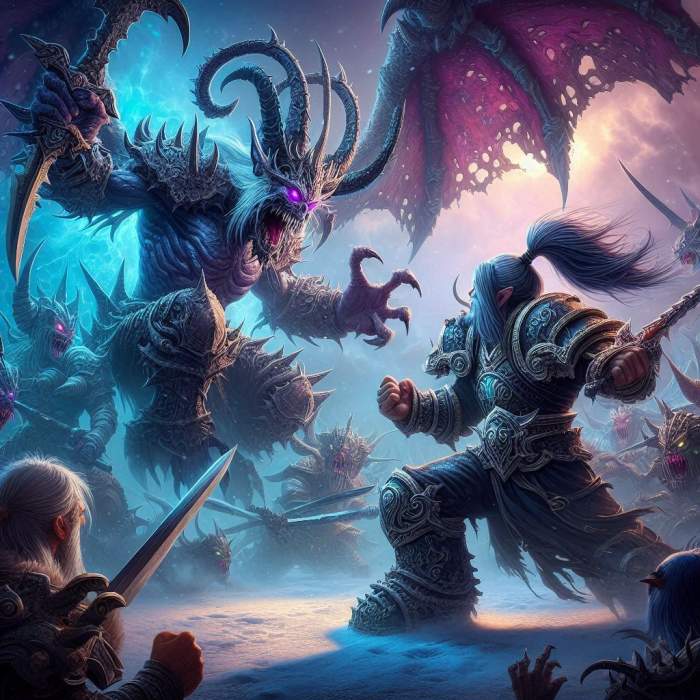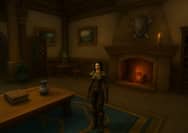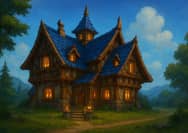As the first season of "The War Within" expansion unfolds, players are eagerly diving into the competitive PvP scene to discover which melee classes reign supreme. With new class adjustments and set bonuses, the landscape of melee PvP has shifted, bringing fresh challenges and opportunities. Luckily, Skill Capped posted a video guide on his YouTube channel. He broke down the melee specs, analyzing their strengths, weaknesses, and overall impact in various PvP scenarios. Whether you're aiming for dominance in arenas or looking to excel in battlegrounds, this guide will help you navigate the melee meta and make informed choices for your PvP journey. If you need gold for your TWW PvP journey, come to MmoGah, a reliable shop that has been in the market for nearly 20 years. Let's dive in.

Tier S
Fury Warrior
Right now, Fury's damage is insanely overturned, one of the main reasons for this being the Slayer tree. This tree is perfect for Fury as it not only massively enhances their already high sustained damage through the various buffs to execute and Bladestorm but also heavily incentivizes and benefits sticking to a single target. Aside from doing ridiculous damage in itself, the courtesy of Culling Cyclone also applies the passive Overwhelming Blades for even more sustained damage on top. Throughout all of Dragonflight, one of the biggest issues with Fury was the bug with the PvP Talent Slaughterhouse. Previously, if there was another healing reduction effect in the game, the Fury Warrior couldn't even begin to build up Stacks. Luckily, after two years, this has now been fixed, meaning not only do our Fury Warriors do the highest sustained damage in the game, but they're also doing it on a target that takes 36% less healing. Fury also has five strong and relatively short cooldown offensives: Recklessness, Avatar, Thunderous Roar, the newly buffed Odin's Fury, and the new addition of Bladestorm. Their only real weakness right now is the survivability. Fury Warriors will be charging straight into our S tier for The War Within Season 1.
Tier A+
Unholy Death Knight
The play style of Unholy Death Knight in TWW is exactly the same as that of DF. With Strangulate replacing Asphyxiate and Virulent Plague being merged into Dark Transformation, it is now simpler than before. The play style still revolves around the consistent high damage of your Diseases and Death Coil, coupled with some huge bursts in the opener by summoning all of your pets and popping Unholy Assault. It has more passive pets, more sustained damage, and more survivability. The talent tree Rider of the Apocalypse grants Death Nnight a random chance to summon one of four Horsemen whenever spending their runes.
Death Knights have seen significant improvement with new passives, such as Null Magic, providing a passive reduction to both the damage and duration of all magic effects; Vestigial Shell that enables you to use AMS to support your team; and Unyielding Will, causing AMS to remove magic effects when activated. They now even get Horsemen's Aid, which causes your Horsemen to also cast AMS on you. Combining all of this with the fact that they can now mount in combat, Unholy Death Knight is worth an A+ tier ranking.
Subtlety Rogue
Moving on to the first of our three Rogue specs, we have what's shaping up to be the strongest of the three – Subtlety Rogue. Between the two trees, top Rogues seem to be gravitating more towards Deathstalker, a tree revolving around Deathstalker's Mark, a three-stack debuff, which is applied to the target by their first Shadowstrike after breaking Stealth or after using Shadow Dance. Any finishers used on the target will remove one of these stacks, and once all three are depleted, the Rogue gains Darkest Night, empowering more burst damage on setups. Aside from that, the tree also substantially improves Subtlety Rogue through talents like Corrupt the Blood and added survivability and mobility through Bait and Switch and Shadewalker. The play style remains fairly identical to what it was in Dragonflight, meaning there's still heavy reliance on their burst damage of Shadow Dance and their extensive crowd control kit to close out games. The noticeably higher sustained damage and added survivability encourage Sub Rogues to play even more aggressively, making it possible to maintain and carry momentum after setups are over. The War Within also brings hefty buffs to Invigorating Shadowdust for even more cooldown reduction and even buffs to Subterfuge for longer stealth windows. All things considered, we will place Subtlety Rogue in the A+ tier.
Assassination Rogue
The Assassination Rogue still shares many similarities in play style compared to Dragonflight, focusing heavily on sustained damage, poisons, and bleeds. The most notable changes going into The War Within are the removal of Shadow Dance and Nightstalker. While this was a significant hit to burst damage, it ended up being heavily compensated for with the buffs to Subterfuge and the addition of two vanish charges. Most Assassination Rogues are gravitating towards the new Fatebound hero talent tree, centered around the key talent Hand of Fate. Though it may seem complex at first, this talent essentially flips a coin each time the Rogue uses a finisher with the goal of landing either heads or tails seven times in a row. If successful, the capstone talent Fateful Ending is activated, granting the Rogue a 7% agility boost for the rest of the Arena. While the tree's focus on passive damage buffs perfectly complements the Assassination play style, it's the Death's Arrival passive that makes it shine. As this combined with two charges of vanish, not only makes it nearly impossible to kite the Rogue, but it also makes maintaining bleeds on multiple targets much easier. With better mobility, improved survivability, and increased sustained damage, Assassination Rogue firmly establishes itself as one of the top melee specs heading into season 1, securing its spot in our A+ tier.
Tier A
Feral Druid
At the end of Dragonflight, Feral Druid was somewhere in the middle of the pack. Although their damage was good, it relied on hard-casting Cyclone. In TWW beta, by selecting the hero talent tree, Druid of the Claw, which enhances single Target burst damage by boosting Ferocious Bite through the talent Ravage combined with talents like Taste for Blood, Saber Jaws, and Ferocious Bite, it became one of the hardest hitting specs in the game. Unfortunately, not only were both of these talents nerfed since then, but it also appeared for years that their tier set wasn't being properly reduced in PvP as it should have been.
But there's still Wildstalker, which is now set to be the go-to choice. This hero talent tree focuses more on bleeds and passive Thriving Growth, giving your bleeds a chance to cause Vines to grow on the target, dealing additional damage. When combined with talents like Adaptive Swarm and Lunar Inspiration, along with the overall buffs to bleeds to address the Ferocious Bite Nerfs, it shifts Feral Druid back into that more bleed Centric play style a lot of Druid players love. Not only has their damage changed, but Feral Druids are also seeing significant boosts to their survivability, an area where they previously struggled. With new talents like Oakskin and additional survivability from various hero talents, and with no need to shift into Caster form to continuously land Cyclones, we put Feral into our A tier.
Survival Hunter
The hero talent tree Sentinel causes Survival Hunter's attacks to apply a stacking buff, with each application having a chance to trigger for some additional damage. Then, the rest of the tree is more passive, like an extra chance to apply Stacks, cooldown reduction when a stack detonates, and some free focus when a stack does damage. Survival is still the same as ever; you've got good sustained damage, coupled with consistent and reliable burst windows, thanks to Coordinated Assault. A noticeable change is that now they have stronger crowd control. Previously, you had to choose among Scatter Shot, Binding Shot, Intimidation or High Explosive Trap to survive, but now, you get all four.
Anyway, for the average player, Survival Hunter will find itself placed inside of our A tier.
Windwalker Monk
The first major change to Windwalker is the removal of Keefer's Skyreach, a talent that previously monks heavily relied on. It plays a crucial role in not only for the Critical Strike component, which was key in setting up their burst damage, but also for the mobility it provided, allowing them to stay glued to their target. To compensate, they now get Clash, causing the Monk and their target to meet halfway at the borderline, rooting all nearby targets and offering a ton of playmaking potential.
Though both hero talent trees look to be playable, it seems Conduit of the Celestials has edged out slightly in front. The key talent is Celestial Conduit, a channeled ability doing AoE damage to enemies around the Monk. Ultimately, with the removal of Skyreach, Windwalker Monks now focuses more on high consistent damage. Taking advantage of Storm, Earth, and Fire, which most notably are now immune to crowd control and roots, makes them far more reliable in PvP.
Their main drawback seems to be a long-standing issue - the lack of reliable crowd control to close out games, a weakness that is even more apparent now with the nerf to Paralysis. As a result, Windwalker Monks rely heavily on maintaining consistent uptime, landing well-timed Leg Sweep and waiting for dampening to close out games. It can be very strong if you're facing a Shadow Priest or Warlock, but if you're facing a Frost Mage who happens to be the most dominant Caster right now, it's not beneficial. So, we decided to put this spec into A tier.
Tier B
Frost Death Knight
Frost DK is one of the most setup-dependent specs in the game, and it is not straightforward to play. It relies on strict timers and flawless coordination with your team, who needs to execute setups every minute. Everybody needs to contribute and be on the same page. However, as we all know, relying on any form of coordination from your team in the Solo Shuffle period isn't a recipe for success. Luckily, it has now changed in The War Within. Instead of being reliant on a coordinated setup every 60 seconds, it's now 45 seconds due to the Hero Talent tree shaping up to be Deathbringer. Once you apply the main ability, Reaper's Mark, to the target, you will gain stacks every time the target takes Frost damage, which explodes once hitting 40, dealing ridiculous damage.
While Frost DK still retains much of the same setup-based play style, there have admittedly been some slight improvements to their sustained damage. All things considered, we are placing Frost DK into our B tier.
Havoc Demon Hunter
The Demon Hunter is one of the few classes with two equally viable hero talent trees. First is Aldrachi Reaver, a tree that focuses on improving the strength of their spenders to bolster their sustained damage. It revolves around Art of the Glaive, a passive that converts your Throw Glaive to Reaver's Glaive after picking up a set amount of Soul fragments, which causes their Chaos Strike to debuff the target with Reaver's Mark and the next Blade Dance to strike three additional times. Those who enjoy having your stuns, crowd control or damage immune will like this tree thanks to Evasive Action. Demon Hunters can now vengeful retreat a second time for a brief period after using the first.
The other tree, Fel-Scarred, is focused more on buffing Demon Hunter Metamorphosis via a passive called Demon Surge. Now, anytime they use the Metamorphosis-enhanced ability, they'll also do some additional fire damage on top to anybody near.
Something that has significantly hurt Demon Hunters in The War Within is the removal of Chaotic Imprint and the substantial nerf to Chaos Brand. These two passives allowed Demon Hunters to synergize exceptionally well with casters and boost their own damage. Besides, with the class remaining almost identical in terms of survivability and crowd control, they're ultimately shaping up to be in a much weaker spot, so let's put it into our B tier.
Retribution Paladin
The new hero talents are a great addition from a design perspective. Herald of the Sun enhances their sustained and cleave damage with a passive damage overtime effect called Dawnlight, which is applied to targets whenever the Paladin uses Wake of Ashes. When the Retribution Paladin activates wings, beams will link to any targets affected by Dawnlight, dealing damage to anyone they pass through. Then there's what appears to be the stronger of the two talent trees – Templar, which places a greater emphasis on burst damage, thanks to the key talent – Light's Guidance. It provides access to Hammer of Light, a powerful five holy power spender that can be used after Wake of Ashes.
Retribution Paladins have consistently faced the same two issues – they lack damage outside of cooldowns and struggle to stay connected to their target. So, Blizzard decided to give them Avenging Wrath all the time, as one of the new additions to their kit is Radiant Glory, which replaces Avenging Wrath and ties to Wake of Ashes. Retribution's lack of finishing power is understandable as this spec relies heavily on secondary stats, like Mastery and Versatility, to perform well. Stats are in short supply at the start of an expansion, so in order to compensate, we may end up seeing Retribution forced to resort back to Crusade and neglect Radiant Glory. All things considered, we will place Retribution Paladin inside of our B tier.
Arms Warrior
The majority of what's new for Arms Warrior doesn't necessarily change the feel of the class. They have a straightforward but still action-packed rotation if they can stick to their target. They can apply consistent high pressure, which is ultimately the core strength of the spec. With the current go-to tree shaping up to be Slayer, this strength has been improved upon. Built around the Slayer's Dominance passive, Slayer focuses on adding additional proc damage while marking the target, increasing the damage they take from executes. It's improving both execute and Bladestorm through various other passives like Unrelenting Onslaught, and it also grants even more mobility through the passive Vicious Agility in Solo Shuffle. Arms Warriors can swap targets and apply pressure to whatever you can hit, contribute to your setups with their low cooldown offensives and sharpen blades, provide multiple stuns whenever you need, and even support you with tools like Intervene, Rallying Cry, and Berserker Shout. At last, we decided to put it into the B tier.
Outlaw Rogue
Honestly, Outlaw Rogue is one of the weird specs that you rarely ever see, and only people who have mained it for several years still bother to play it. In the War Within, the only real direct change to Outlaw comes with the removal of Shadow Dance, which is now replaced by two charges of vanish. Most people choose Fatebound for the hero talent tree, which makes sense as it is mostly focused on improving passive damage above all else. We can say with certainty that Outlaw is nowhere near the level of either Sub or Assassination, so we put them into B Tier.
Tier C
Enhancement Shaman
Enhancement Shaman is accepted as the worst spec in Solo Shuffle. The good news is that Enhancement hero talents are looking good. Stormbringer is the more lightning-based tree. The main hook of the tree Tempest requires a lot of RNG and uptime but provides some pretty high burst damage. Meanwhile, Totemic is more built around improving Lava Lash with the whole Lava Lash flame shock maximum AoE spread damage build. Aside from hero talents, the only other real difference going to The War Within is the new Stone Bulwark Totem, a 3-minute cooldown absorb for the Shaman and their team, which is very strong but can easily be purged.
Enhancement's damage is lackluster, heavily relying on procs or continuous uptime for the majority of it to make an impact. They suffer from noticeable mobility issues, and their crowd control is unreliable. So, this leaves Enhancement Shaman right at the bottom of the rank in season 1, tier C.



